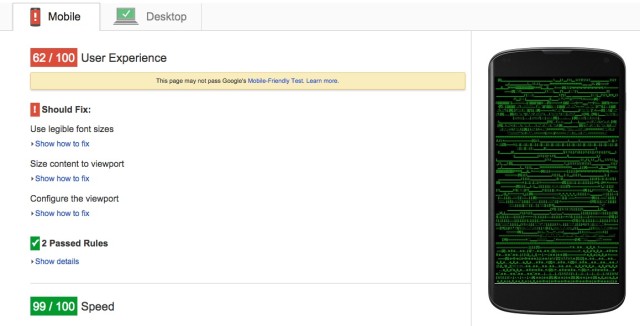Google’s search algorithm has changed: responding to a surge in mobile Internet use, the company started rolling out its “mobile-friendly update.” In sum, websites designed for phones and other on-the-go gadgets will rank higher in mobile search results. Large text, ample spacing between links, and vertical scrolling are all preferred in the company’s mobile-search test.
On the one hand, Google spurs along the inevitable: more and more people are accessing the web via mobile, so major companies should be caught up to speed. On the other, Google is forcing adaption—after all, this is a major corporation saying what websites should and should not look like. When we search, it’s like we’re casting out our fishing rods, in hopes of reeling in aquatic life. Google wants us to hook a rich, delicious fish—bluefin tuna, maybe—but that’s not what everyone wants. What if we prefer catfish, seaweed, or even a boot full of holes? Sometimes I’m just looking for a crappy website.
Many specialized websites, such as art websites, may not want to optimize; that could create search issues. Take, for example, “Anatomize,” a recent web exhibition of clickable body parts designed by artist Rollin Leonard. It doesn’t fare well in the Google mobile test. Offensives include that the text is “too small to read” and the links are “too close together.” (Test here.) But that’s part of the intent.
“I don’t care about [the update] because it is not meant for the phone,” says Rollin Leonard. “These kinds of projects require some effort to view and I like it that way.”
Leonard is a visible member of the online art community, a group likely to be impacted negatively by Google’s algorithm change. Artists’ websites that aren’t meant to be pretty—glitch art, for instance, which focuses on errors and unstable formats—won’t rank highly in mobile search results.
Neither will websites and online art projects developed prior to mobile Internet use . Historically important net.art sites like Olia Lialina’s “My boyfriend came back from the war,” 1996, contains pages with small text that don’t rank highly in Google’s algorithm. Jodi’s homepage matrix of green-and-black has been resistant to change for years, but similarly fails the test. Horizontal-scrolling websites that wouldn’t make the cut either (Rob Wittig’s “El Dorado,” 1998).
Mobile-functionality, at the risk of the archive.
As the Internet gets older, we need to start making distinctions between sites of historical importance, those purposely made to be mobile unfriendly, and purely utilitarian commercial sites in need of an upgrade. (See: “Mapping the Web.”) Google doesn’t take into account those differences; by burying the past to the bottom of a search, Google reshapes Internet history in a way that makes it impossible to find if you don’t already know what you’re looking for. (Discovery is an issue Google has long struggled with.)
Who knows what direction Google will take on archiving the web, or how far down the search query they’ll push mobile-unfriendly sites. What we do know is they’re pushing the Internet to be a place of its own user-friendly design—not everyone searches the web for the same reasons. Most of us will be fine with what Google brings us, but for those of us who actually see websites as part of a living archive, Google has made the web a whole lot less diverse, and less pleasurable.



{ 3 comments }
The same type of argument could be made for any of the myriad ways that google ranks search results. The fact is, mobile-friendly is one of many criteria. It’s very unlikely to result in less diversity. Very little, if any artists websites are found through cold google searches. You tend to know the artist’s name or some specific information about what you’re looking for. If I search Rollin Leonard I’m going to get Rollin’s site because it is the best source of information about Rollin’s work.
This article takes as its basic premise that a google search is the starting point to all internet browsing experiences. While this might be true for some number of search-savvy web users, I don’t see that being a behavior that has big ramifications for artists working on the web. I have never sat down at a computer and typed “show me some net art” into a google search bar, nor have I spoken these words to my phone’s voice-responsive AI. I find my daily pleasurable viewing through my highly tuned social network of smarty types, artists, critics, and radical individuals with diverse tastes. Google doesn’t care about navigating online art scenes. Also, we all gotta step back and ask ourselves whether it actually really matters that our project shows up in google results.
Only smartphones are impacted. Google’s search results on desktop and tablets will be unaffected by the new algorithm.
Comments on this entry are closed.